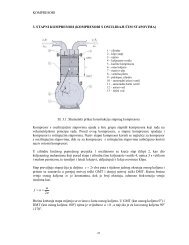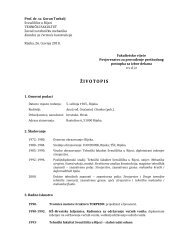universityâenterprise cooperation
universityâenterprise cooperation
universityâenterprise cooperation
You also want an ePaper? Increase the reach of your titles
YUMPU automatically turns print PDFs into web optimized ePapers that Google loves.
In the future, other structures can be added,<br />
such as restaurants, a technical museum<br />
targeted at practical introduction of high<br />
school students into R&D, legal advisory,<br />
etc. The Science & Technology Park is a rather<br />
broad concept used to describe various attempts<br />
at stimulating development entrepreneurial,<br />
knowledge-based small and mediumsized<br />
enterprises (SMEs) within a country.<br />
Although there are several definitions of<br />
STPs, the fact is that they represent an<br />
agglomeration of SMEs, which have the<br />
following characteristics:<br />
• They are linked to education and research<br />
institutions;<br />
• They offer infrastructure and services<br />
for the activities of the hosted SMEs,<br />
primarily real estate and business space;<br />
• They facilitate the process of technology<br />
transfer; and<br />
• They are intended to stimulate the industrial<br />
development of the region where they are<br />
located.<br />
The basic aims of the STPs will be to provide<br />
a favorable environments and infrastructure<br />
and to support the creation and growth of new<br />
enterprises which commercialize innovations<br />
from universities or research institutes.<br />
The activity of STPs includes offering an<br />
entire set of services to tenant companies, in<br />
order to help them survive on the research and<br />
development market. The motives for founding<br />
STPs in WBCs are industrialization, regional<br />
development and the creation of synergy. The<br />
goal of these Parks is to stimulate economic<br />
growth in the region by:<br />
• Creating an atmosphere suitable to the<br />
development of innovative activity;<br />
• Support of entrepreneurship in the<br />
scientific-technological sphere;<br />
• Forming of an infrastructure which<br />
stimulates the creation and development<br />
of small innovative companies;<br />
• Technology transfer;<br />
• Commercialization of the results of<br />
scientific and technological research;<br />
• The employment of the best students<br />
who finish their courses of studies.<br />
In WB region S&T Parks will be also used<br />
to attract foreign investment for creating<br />
jobs in the domain of high technology 1 and<br />
increasing the governmental budget. One of<br />
the important goals is also to prevent braindrain<br />
phenomena which have been specific<br />
for WBCs in previous period.<br />
These STPs should be funded partly by<br />
Ministries of Sciences and Technological<br />
Development (or equivalent) and partly<br />
through rents earned from their tenant<br />
companies. Private investors and venture<br />
capital funds can also invest resources in<br />
order to make a profit later on. Obtaining<br />
these resources for companies will be one of<br />
the most important functions of the park’s<br />
management. Within the Parks should be<br />
developed and promoted the entrepreneurial<br />
spirit among science students and staff, and<br />
to encourage them to set up small hightechnology<br />
companies. The STPs will provide<br />
tenants with professional educational<br />
courses, organize participation of tenant<br />
companies in international trade fairs and<br />
will provide consultations on development<br />
strategies, financing, participation in markets<br />
and placement of products.<br />
6.3.1.1 Technology Transfer Center<br />
Technology transfer is defined as a transfer<br />
of knowledge, scientific or technical knowhow,<br />
technology, technology-based ideas or<br />
research results, developed within an academic<br />
institution, from academic institution to industry,<br />
where an academic institution may or may not<br />
have the property rights for commercialization<br />
of such scientific or technical know-how,<br />
technology or research results.<br />
Politicians in European Union also recognized<br />
the importance of technology transfer from<br />
academia and establishment of spin-offs,<br />
therefore European Union funds projects<br />
such as PROTON (pan-European network of<br />
Technology Transfer Offices and companies<br />
affiliated to universities and other Public<br />
Research Organizations), PRIME (Policies for<br />
Research and Innovation in the Move towards<br />
1 There are some initiatives in the ICT area, such as<br />
the upcoming Technology Park at Indjija - located 30 km<br />
south of Novi Sad, Serbia<br />
105<br />
New WBC model of university-enterprise <strong>cooperation</strong> 6
















